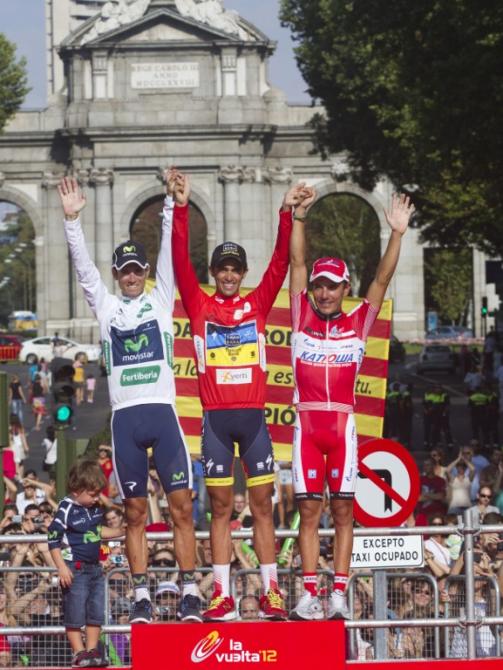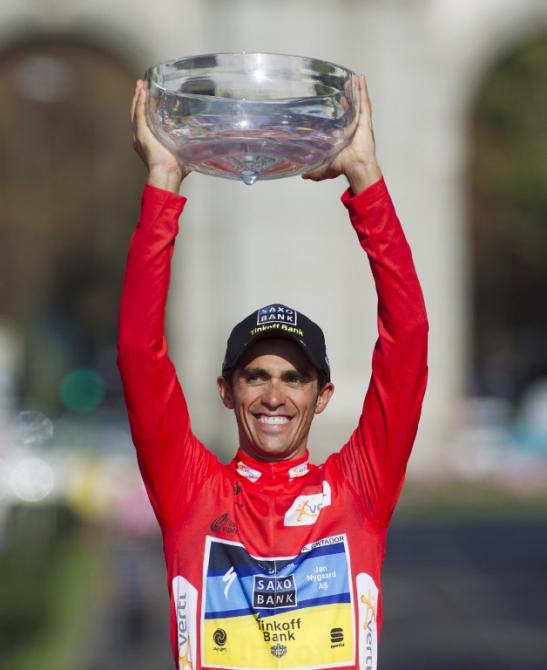Vuelta aims high with 11 summit finishes
2013 route to contain one more mountain-top finish than 2012?


Short, lung-burstingly steep ‘walls’; 17.3km-long gentle but interminable ascents; two mountaintop finishes in the race’s first three days and the Angliru to finish off with – should Spanish media reports on Friday be believed, the 2013 Vuelta a España will be a guide to all the different varieties of mountain climbs possible within a single stage race.
According to Spanish newspaper As, the 2013 Vuelta will have no fewer than 11 summit finishes – that’s an average of more than one every two days. The decision to maintain such a climb-heavy course is partly inspired, it is thought, by the huge increase in public interest in the Vuelta in 2012, which contained no fewer than ten uphill finishes of one sort or another scattered throughout the course and which developed into a fiercely fought three-week battle for the red leader’s jersey as a result.
The route itself is due to be presented on Saturday, January 12 in Vigo. Running from August 24 to September 15, the opening three days will create some important differences, according to the As report. The initial team time trial through rugged coastal territory will be followed by two short, steep uphill finishes, at Alto da Groba and the Mirador de Lobeira, and by a return of the Mirador of Ezaro climb – where Joaquim Rodriguez (Katusha) won in 2012 with one of his trademark late attacks – midway through stage four.
After sweeping southwards through the little-known province of Extremadura, perhaps after taking in a stage on the 2014 Worlds circuit in Pontevedra, three stages in Andalusia on three consecutive days – completely bypassed in 2012 – provide the next ‘package’ of uphill finishes. The first, As claims, will be a 16-kilometre climb near the coastal town of Estepona which has never previously been tackled in the Vuelta, whilst the second, an agonisingly short, steep, effort at Valdepeñas de Jaén, which first featured in 2010, has already become one of the race’s most popular ascents in a very short space of time. The third in Andalusia, at Haza Llana in the foothills of the Sierra Nevada mountain range, is also likely to create a major sort-out at the top end of the peloton given that it has ramps of up to 22 percent in an eight kilometre ascent.
Also back on the menu, according to As, will be the Collado de Gallina in the Pyrenees - the climb that saw the top end of the overall classification whittled down to Alberto Contador (Saxo-Tinkoff), Alejandro Valverde (Movistar) and Joaquim Rodriguez (Katusha) last year as Chris Froome (Sky) fell behind for the first time. The Collado will be preceded by the race’s one long individual time trial, in Tarazona, Aragon and followed on by two more Pyrenean stages with as yet unspecified climbs.
If that were not enough mountain climbing, As claims that the third week will culminate with a stage to Fuente De – scene of Contador’s race-winning move this year. This will then be followed on by an ascent of the Naranco, one of the most frequently used climbs in the Tour of Asturias and formerly the summit finish of the one-day Subida a Naranco, and the race will conclude with the Angliru, Spain’s single toughest climb, just 24 hours before the finish in Madrid.
Get The Leadout Newsletter
The latest race content, interviews, features, reviews and expert buying guides, direct to your inbox!
Alasdair Fotheringham has been reporting on cycling since 1991. He has covered every Tour de France since 1992 bar one, as well as numerous other bike races of all shapes and sizes, ranging from the Olympic Games in 2008 to the now sadly defunct Subida a Urkiola hill climb in Spain. As well as working for Cyclingnews, he has also written for The Independent, The Guardian, ProCycling, The Express and Reuters.
